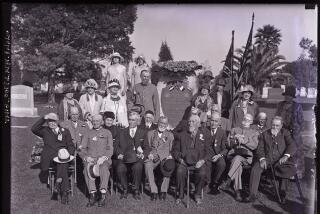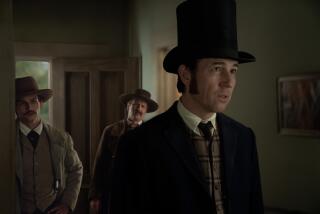Shelby Foote, 88; Novelist, Historian, Commentator on Ken Burns’ ‘Civil War’
Southern novelist and historian Shelby Foote, who chronicled Mississippi Delta life in his fiction and created a panoramic history of the Civil War, died Monday in Memphis, Tenn., his wife, Gwyn, said Tuesday. He was 88.
No cause of death was given.
Best-known for the courtly eloquence he brought as commentator to Ken Burns’ 1990 PBS documentary, “The Civil War,” Foote belonged to a rich tradition of Mississippi storytellers that has included William Faulkner, Walker Percy and Eudora Welty.
It was his appearance in Burns’ film, enthralling its 40 million viewers with his battlefield-eye-view of the war, that first gained this singular American storyteller the recognition of a wide audience.
“One of the reasons why that documentary worked itself into the bloodstream of this country is because of Shelby,” Burns said.
Slight of build, his gray beard trimmed close to the jaw, Foote vividly evoked the horrors of 19th century warfare, such as the hail of bullets that cut men down at Shiloh, as well as the war’s smaller moments -- days when rations ran so low that soldiers ate sloosh, a mixture of cornmeal and bacon grease. And he did it with a charming, mellow voice that seemed dipped in Delta mud.
“Shelby had a way of talking about the war that blew everyone else out of the water,” Burns said. “He understood, as few historians do, that the word ‘history’ contains the word ‘story.’ I’m really going to miss him, miss the sound of his voice.”
In an epic prose style, Foote told stories like an American Homer, producing over 20 years “The Civil War: A Narrative” in three volumes -- “Fort Sumter to Perryville,” “Fredericksburg to Meridian” and “Red River to Appomattox.”
“The American Civil War is an experience central to our lives,” Foote explained in a 1987 interview contained in “Conversations With Shelby Foote,” edited by William C. Carter. “The Civil War, for us, was very much similar to the Trojan War for the Greeks; the Civil War is our ‘Iliad.’ ”
Hailed by some as an important new telling of the war, Foote’s story of a nation divided was especially resonant for Americans during the tumultuous ‘60s and ‘70s when it appeared.
The “credit for recovering [the Civil War’s] majesty to the attention of our skeptical and unheroic age will hereafter belong peculiarly to Mr. Foote,” wrote the historian M.E. Bradford, reviewing the first volume for the National Review.
“Peculiarly” seems strange in a statement of praise, yet Foote was a man of many paradoxes: a novelist who won renown for a work of history; a recorder of great military feats who had been a self-described mediocre soldier in World War II, and an opponent of racial segregation who still loved the Confederate flag. During the controversy in 2000 over the flag on South Carolina’s state capitol, Foote said its original symbolism of states’ rights had been perverted by extremist groups such as the Ku Klux Klan.
Despite his contributions to American literature, Foote never won the Pulitzer Prize or the National Book Award, although he was inducted into the Academy of Arts and Letters in 1994 when he was 78. Friends such as Carter suggested that the literary community didn’t know what to think of Foote, who eluded easy categorization as either a historian or fiction writer.
“I suspect that fiction writers felt he’d abandoned their camp, and the historians sniffed at him like some outsider,” Carter told the Los Angeles Times. “But then, Shelby never paid much attention to such things anyways. He always followed his own path, even if it took him to places he never intended.”
Until Burns’ film brought him widespread attention (and marriage proposals from smitten viewers, which greatly amused him), Foote shunned the spotlight, quietly working a 9-to-5 schedule in an upstairs room of his Memphis home. Like a man from another century, he composed the trilogy -- more than 1.5 million words in all -- with an old-fashioned dipped-ink pen. A picture of Marcel Proust, a literary hero, hung above his typewriter.
Foote once told his lifelong friend Percy, “For God’s sake, Walker, do not listen to anyone who would try in any way to tell you how to shape a book. If you let anyone fiddle with your way of seeing
Foote was born Nov. 17, 1916, in Greenville, Miss., to a family that helped settle the Mississippi Delta. He was the only child of Lillian Rosenstock and Shelby Foote Sr., a meat-packing executive who died of blood poisoning when Foote was 6.
The traditions of the South were embodied in Foote’s great-grandfather, Hezekiah Foote, a landowner and Confederate colonel whose horse had been shot from under him at the battle of Shiloh, although he survived. Foote’s paternal grandfather, Huger, typified another kind of Southern gentleman, the rich man’s son who lost much of the family fortune to gambling, a story Foote tells in his first novel, “Tournament.”
Foote nurtured literary ambitions that thrived in the region’s rich storytelling atmosphere. Though he spent time as a journalist, radio writer, U.S. Marine and, briefly, college student, Foote found his true calling after publishing stories of Delta life in the Saturday Evening Post in the late 1940s. Until the early 1950s, he was “one of the movers and shakers on the literary scene,” said the novelist George Garrett, a friend of Foote.
“Shelby was a hot ticket,” Garrett said. “He was writing a book a year, and those books got a lot of attention.”
Foote received critical praise for the depth and variety of his stories. In the novels “Tournament,” “Follow Me Down,” “Love in a Dry Season” and “Jordan County,” dispossessed Indians, ruined aristocrats and plantation families parade across the stage of a mythical county, dramatizing the decline of the old agrarian ideal.
Foote’s portrayal of the dynastic ambitions of the past and the waste and sterility of the present made comparisons to Faulkner’s Yoknapatawpha County stories inevitable.
But, Garrett said, anyone who thought Foote was imitating Faulkner had “missed the point.”
“Think of what [poet and playwright John] Dryden faced coming after Shakespeare, and it’s really very similar. Shelby knew what he was doing. He dared critics to make the comparison.”
Foote would finally step out from his fellow Mississippian’s shadow by turning to narrative history. On the merits of the 1952 novel “Shiloh” -- Faulkner, comparing it to “The Red Badge of Courage,” called “Shiloh” “twice the book” of Stephen Crane’s legendary account of the Civil War -- Random House asked Foote in 1954 to write a short history of the Civil War. That project turned into three volumes that would absorb most of Foote’s career.
Through three Guggenheim grants, Foote pursued the project, drawing on regimental records, visiting battle sites to get a sense of the topography and finding inspiration in the Greek classics.
“The Civil War: A Narrative” ranges linguistically from the long, rolling sentences of an ancient Greek chronicler to phrasing that is as crisp as Ernest Hemingway’s.
“It’s an extraordinary performance in American letters,” Carter said. “The story has a powerful forward momentum, on all levels, that’s never lost or snarled up for over 3,000 pages.”
“The red flags of the Confederates staggered backward,” Foote writes of a sudden reversal in the battle at Antietam, “and still the bluecoats came on, driving them through blasted corn and through the early morning woods, until at last they broke and fled, their ranks too thin to rally.”
Elsewhere, his prose is sown with rich, sensory details.
“Regiment by regiment,” he writes of Union forces crossing a river on the way to disaster at Chancellorsville, “the three road-worn divisions entered the foam-flecked, scrotum-tightening water and emerged to toil up the steep south bank, which became increasingly slippery as the slope was churned to gumbo by the passage of nearly 16,000 soldiers, all dripping wet from the armpits down.... Low in the east, the late-risen moon, burgeoning toward the full, had the bruised-orange color of old gold ... the men lay rolled in their blankets, feet to the fire.”
Where previous military histories clung to the viewpoint of a particular side, Foote strove to tell it objectively. He was awed as much by Abraham Lincoln as Confederate Gen. Robert E. Lee. And he admired Lincoln’s genius at riding circumstances compared with Confederacy President Jefferson Davis’ propensity to hold rigidly to plans.
Not all the critics were impressed with “Civil War.” A few complained that Foote, in keeping to the story of guns and battle, overlooked larger questions of economics and ideology.
But esteemed historian C. Vann Woodward, writing in the New York Review of Books, called these criticisms “patronizing,” arguing that professional historians had abdicated the role of “the oldest and most honored role of the historian, that of storyteller” to Foote and his “impressive narrative gifts.”
Characteristically, Foote was untroubled by debate over his work, preferring to talk instead about the lingering legacy of the war, especially for Southerners.
“If anybody ever lost a war, we lost that one,” Foote told historian Hampton Sides in 1986. “It is a profound sense of the tragedy of life. Getting whipped is a hell of an experience. If you’re a kid in a fistfight, and you really get beat up bad one time, you learn a lot from it.”
That historical awareness remained prominent in the various projects that occupied Foote after completing the trilogy.
In the 1960s, he served as playwright-in-residence at the Arena Stage in Washington, D.C., and wrote a screenplay for director Stanley Kubrick that was never filmed.
In 1978, “September, September,” a novel about the 1957 kidnapping of a black man by rednecks in Memphis, was published. It was his last novel.
He continued to give lectures and work on an epic novel called “Two Gates to the City” that was never published.
Foote might have ended his days in relative obscurity if Southern novelist and onetime U.S. poet laureate Robert Penn Warren hadn’t phoned Burns one night.
“He told me, ‘If you’re going to do anything on the Civil War, you have to talk to Shelby Foote right away,’ ” Burns recalled in an interview.
In making “The Civil War,” Burns -- who in his “Brooklyn Bridge” and “Jazz” documentaries, used up to 75 speakers each -- relied almost exclusively on Foote, who appears 89 times.
“Shelby so understood the story that it ruined it for anybody else. He was it,” Burns explained.
Their work together was akin to friendly chats, with Burns tossing out the name of a battle or personality and Foote weaving a portrait through anecdote and aphorism. Foote’s personal accounts of the war were so moving that the filmmaker decided to use sound effects while Foote talked, something Burns said he normally never did when an expert was on screen.
“I dip down the effects a little when Shelby’s speaking,” he explained, “but I wanted to keep that sense of being there in the moment that he was creating.”
The documentary’s success -- in addition to attracting millions of viewers, it won two Emmys in 1991 and numerous other awards -- led to an autumnal appreciation of the author, then in his 70s. His novels were reissued, sales of the trilogy climbed from about 30,000 to half a million, and Foote found himself in the unexpected, sometimes humorous circumstances that fame creates.
During a 1991 literary festival in Nashville, Foote encountered one enthusiastic fan as he, Garrett and novelist Fred Chappell stood in the lobby of their hotel.
“A woman rushed up to Shelby and planted a kiss on his cheek. Then she said, ‘What was Gettysburg like?’ ” Garrett recalled. “By that time, Shelby had gotten tired of explaining that he hadn’t been there. So he just looked at her and said, ‘Madam, it was hell.’ ”
Burns said Foote’s compassion and warmth helped the filmmaker through some trying moments during the making of the documentary.
“There’s a moment in the film,” Burns said, “when Shelby describes how [Union Gen.] Ulysses S. Grant had this special strength that showed itself when everybody else’s was failing. He called it ‘4 o’clock in the mornin’ courage.’ ”
“Sometimes I’d call him, all in anguish about the film’s plot, the structure. He’d say, ‘Take it easy. Just remember that God is the greatest dramatist.’ That helped me more than anything on Earth. Shelby gave me ‘4 o’clock in the mornin’ courage’ too.”
In 1999, the Modern Library ranked Foote’s “The Civil War: A Narrative” as No. 15 on its list of the century’s 100 best English-language works of nonfiction.
Besides his wife of 49 years, Foote is survived by his daughter, Margaret, and son, Huger. A graveside service is planned in Memphis on Thursday.
More to Read
Sign up for our Book Club newsletter
Get the latest news, events and more from the Los Angeles Times Book Club, and help us get L.A. reading and talking.
You may occasionally receive promotional content from the Los Angeles Times.








